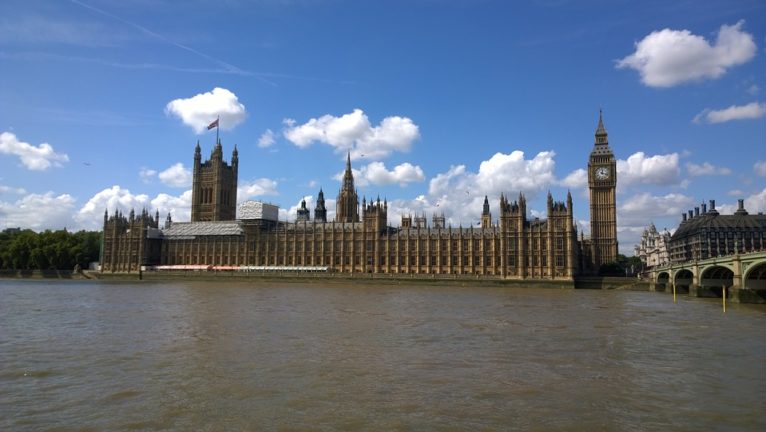The Environment Bill : A framework for progressive environmental law?

Prime Minister Boris Johnson has described the recently published Environment Bill as ‘a lodestar by which we will guide our country towards a cleaner, and greener future.’
And this Bill is indeed extraordinary in its scale and its scope. But it has a very big space to fill: with Brexit, the UK leaves behind EU legislation on the environment, and the shared expertise and democratic processes for governing both compliance and legal development.
The Bill’s 232 pages cover environmental issues from plastic pollution to smoke control. I focus here on Part 1, ‘Environmental Governance’.
The Queen’s Speech described this part of the Bill as follows:
For the first time, environmental principles will be enshrined in law. […] Legislation will also create new legally-binding environmental improvement targets. A new, world-leading independent regulator will be established in statute to scrutinise environmental policy and law, investigate complaints and take enforcement action.
Not all of these grand political claims withstand scrutiny.
‘For the first time, environmental principles will be enshrined in law.’
This is doubly wrong.
First, the environmental principles listed in the Bill (integration, prevention, precautionary principle, source principle, polluter pays principle, clause 16(5)) are already ‘enshrined in law’ in the UK, because the EU treaties make them part of UK law.
Currently, the environmental principles are binding on all public authorities (when applying law within the scope of EU environmental competence), in all relevant cases, including individual administrative decisions. That does not mean that the principles dictate a particular outcome. The outcome depends on the legislative context. But there is a legal obligation on all public authorities to apply the principles whenever relevant.
Second, the Bill will not ‘enshrine’ the principles ‘in law’. On the contrary, it ensures that these legal principles become purely matters of policy. Clause 16 requires the Secretary of State to draft a ‘policy statement on environmental principles’. ‘Ministers of the Crown’ (only) ‘must, when making policy’ ‘have due regard to’ the policy statement’ (clause 18). This requirement does not apply to administrative decisions (clause 41) and is subject to far-reaching exceptions.
This fundamental failure undermines assurances that government intends to ensure at least equivalent legal protection of the environment after Brexit. Many of the critiques that Eloise Scotford and I made of the principles in the earlier draft Bill are just as relevant today.
‘Legislation will also create new legally-binding environmental improvement targets.’
The Secretary of State ‘may’ ‘set long-term targets’ on ‘any matter’ relating to the natural environment or people’s enjoyment of it, and ‘must’ set a long-term target ‘in respect of at least one matter’ in four priority areas of air quality, water, biodiversity and resource efficiency and waste reduction (clause 1). Clause 2 requires a PM 2.5 target to be set. Clause 4 provides that ‘it is the duty of the Secretary of State to ensure that’ those targets are met.
So there will indeed be new legally binding targets. But ‘bindingness’ is not straightforward.
- First, while the Bill contains an obligation of result (‘It is the duty…’), the targets themselves could include softening language, e.g. of reasonableness, appropriateness or cost-effectiveness, which makes them difficult to enforce. The requirement that the targets must be ‘capable of being objectively measured’ (clause 1(4)) may partially mitigate that concern, but does not remove it.
- Second, whilst long-term targets are necessary, the minimum fifteen-year time span (clause 1(6)) pushes legal compliance far into the future. Five-yearly interim targets are required, but they are set in policy not law (clause 10). These interim targets come with procedural obligations, and a framework of monitoring and review (clauses 15 and 23). But they are not legally binding.
And are the targets necessarily ‘environmental improvement targets’?
The Bill does contain a nod towards ensuring that targets ‘significantly improve the natural environment’ (clause 6). This is not an obligation when individual targets are set, but a test by which the targets are cumulatively reviewed. The Secretary of State must review the targets and publish a report, laid before Parliament, stating whether she ‘considers’ that the ‘significant improvement test is met’, and if not, ‘the steps’ to be taken ‘to ensure that it is met’. Whether this approach to the ‘significant improvement test’ can really bear the weight of ensuring progressive environmental law after Brexit is doubtful.
- First, the test’s cumulative nature (taking all targets together, including those set under other legislation), combined with the elasticity of ‘significance’ as a legal notion, allows for backwards steps in some areas (even important ones), if improvement is taking place elsewhere. Further, ‘significant improvement’ seems to pit the targets against current environmental conditions (rather than against existing targets). Importantly, the Bill does not refer to existing targets and standards. These clauses open up the way for immediate regression and de-regulation from standards to which the UK is currently legally committed as an EU member state.
- Second, ‘lowering’ (‘weakening’ would be clearer) the standards is explicitly permitted (clause 3(3)). Targets may be revoked or weakened if the Secretary of State is ‘satisfied’ that meeting the target would ‘have no significant benefit’ or when, ‘because of changes in circumstances … the environmental, social, economic or other costs of meeting it would be disproportionate to the benefits’. This is very open-ended, leaving considerable scope for regression even from targets set under the provisions of the Bill themselves.
The Bill contains only limited procedural protections that might enhance the quality of the targets.
- First, the Secretary of State must ‘seek advice from persons the Secretary of State considers to be independent and to have relevant expertise’ (clause 3); the Secretary of State’s discretion in identifying relevant advisors is unlikely to be successfully challenged, other than in the most extreme circumstances. There is no obligation to publish the advice, and there is no broader obligation to consult. It is striking that there is no obligation to seek advice from the Office for Environmental Protection (OEP), but merely the power to do so (clause 25).
- Second, Parliament must approve the new targets, since the affirmative procedure applies. But Parliament cannot amend proposals under this procedure, and simply rejecting targets is an unappealing response to concerns about their weakness.
- But third, ‘policy’ (counterintuitively) includes ‘proposals for legislation’ (clause 41), so the environmental principles policy statement applies.
The potential of these binding targets to create a framework of progressive and enforceable environmental law depends entirely on whether the targets are sufficiently comprehensive and ambitious. The Bill is open on that.
‘A new, world-leading independent regulator will be established in statute to scrutinise environmental policy and law, investigate complaints and take enforcement action.’
This is the OEP, which made its first appearance in the draft Bill published at the end of 2018.
On the face of the Bill, the Secretary of State appoints and dismisses the non-executive members of the OEP, without the involvement of Parliament, and sets the OEP’s funding in the normal way (Schedule 1). The OEP’s lack of independence was criticised during pre-legislative scrutiny of the draft Bill by the House of Commons EFRA and Environment Audit Committees, and little progress seems to have been made.
There are important (if imperfect) provisions for monitoring and reporting on policy and targets (clause 23), and on the implementation of environmental law (including the clause 1 and 2 targets) (clause 24). These provide potentially important mechanisms for deliberation and debate on environmental protection, and routes for political accountability.
Complaints from members of the public to the OEP (clause 27) provide a form of access to justice, but its effectiveness is determined by the OEP’s ability to address the problem, including by what the Queen’s Speech refers to as ‘enforcement action’.
Such as they are, the OEP’s powers of ‘enforcement’ are narrowly framed around a ‘failure to comply’ with environmental law. The Secretary of State has the power by regulation to remove ‘legislative provisions’ from the definition of ‘environmental law’ (clause 40). ‘Failure to comply’ means ‘unlawfully failing to take proper account of environmental law when exercising … functions’, or ‘unlawfully exercising, or failing to exercise’ functions (clause 26(2)). This is problematic. Most obviously, law is not something to be ‘taken account of’ (properly or otherwise) – it is to be complied with. And the reference to ‘unlawfulness’ simply emphasises a traditional approach, narrower than the current EU approach, which is likely to be dominated by procedural compliance and unusual cases, rather than environmental results.
A long and weak enforcement process
There are four steps in the process. If the OEP, following investigation (clause 28) ‘has reasonable grounds for suspecting that the authority has failed to comply with environmental law’, and ‘it considers that’ the failure would be ‘serious’ (probably not a major additional hurdle – but if not, one wonders why it is necessary), it may issue an ‘information notice’ (clause 30). This requires the recipient to provide information on the alleged failure, and ‘to explain what steps (if any) [it] intends to take in relation to the allegation’.
If the OEP is at this point ‘satisfied, on the balance of probabilities’ that there has been a failure to comply, and it considers the failure serious, it may issue a ‘decision notice’ (clause 31). This notice describes the breach and sets out steps to be taken. The recipient is not required to comply with the decision notice, but has a procedural obligation to respond, stating whether it agrees that the failure has occurred, whether it will take the steps set out, and any other steps it will take.
The OEP may at this stage apply to the Upper Tribunal for ‘environmental review’ of the alleged unlawful conduct (clause 33). This is ostensibly a new process, picking up on the recommendation of a ‘bespoke’ process by the Environmental Audit Committee.
However, it looks very much like judicial review, with all of its strengths and limitations, in a different forum. So the Upper Tribunal ‘must determine whether the authority has failed to comply with environmental law, applying the principles applicable on an application for judicial review’. There is no additionally intense or expert scrutiny of public authority action. The Upper Tribunal can provide any of the remedies available in judicial review (the ‘statement of non-compliance’ in the Bill looks like a declaration) with the explicit exception of damages.
In sum, whilst it may have a significant role in contributing to political accountability, the OEP’s legal enforcement powers are strikingly weak.
Conclusions
Strong institutional frameworks for law and governance matter. They allow for environmental integrity regardless of the interests and values of the government of the day, or the salience of the environment in the political moment, and they mean that civil society does not have to fight every single issue from scratch.
This Environment Bill does not achieve that. It is not without its strengths, especially around political rather than legal accountability, and in the right circumstances it could provide a framework for progressive environmental law. But it also and worryingly enables the pursuit of an immediate de-regulatory agenda.
About the author
Prof Maria Lee is Professor of Law at University College London, at UCL Centre for Law and Environment (on Twitter @UCLlaw_env). Maria’s research interests lie in the law and policy of environmental protection. She is particularly interested in the ways we make decisions on environmental matters, especially in areas of high technological complexity and controversy. She concentrates on the governance of decision making, examining the use of expertise, public participation and varied regulatory approaches.





The Ecological Crisis and UK Policy | Guest Post | The Family Patch
8th December 2019 at 2:56 pm[…] the targets will be met at all, and legal enforcement might be difficult to achieve. In fact, another expert in environmental law has described the planned enforcement process as “long and weak”. She also raises additional […]